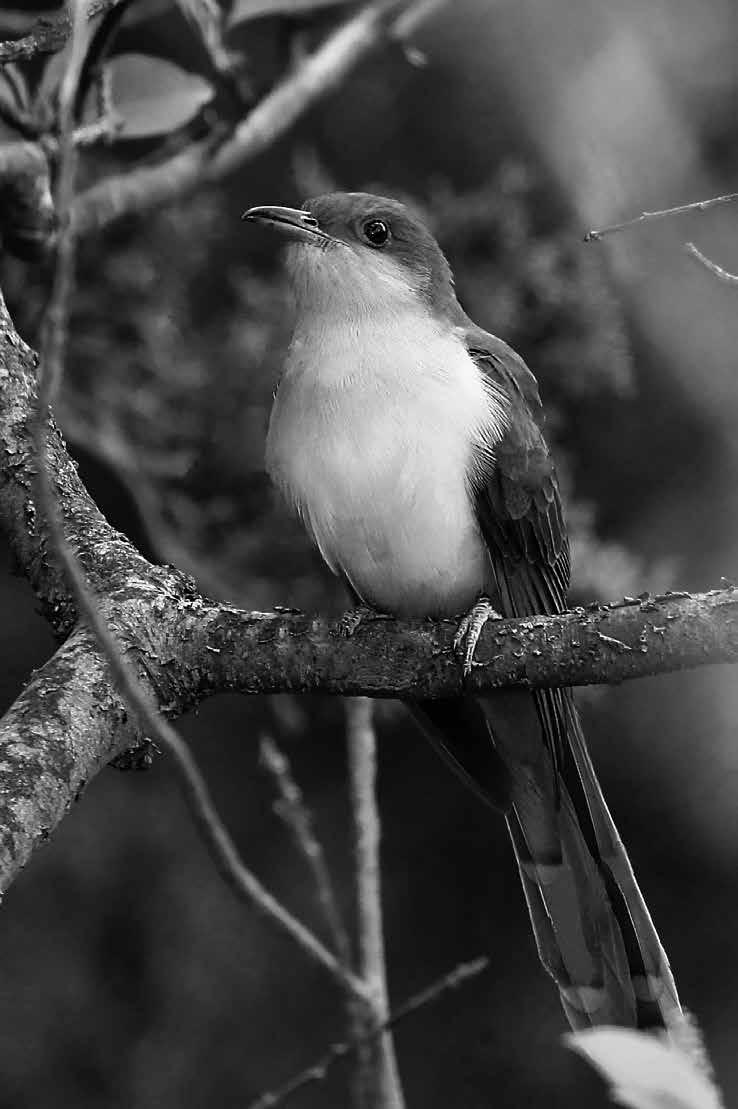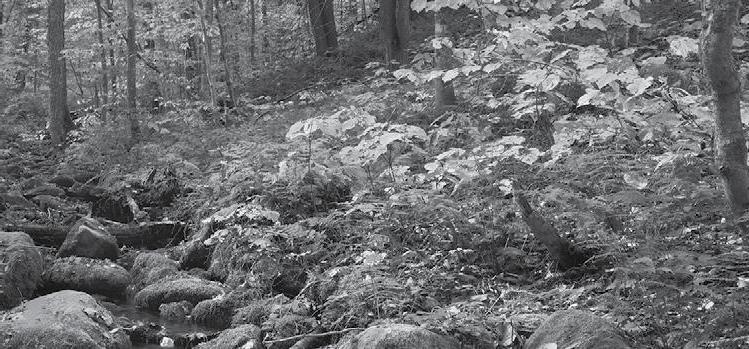
4 minute read
Sulliv nristi K
Wild Things in Your Woodlands
Kri ti Sulli a
Advertisement
Bl ck- illed Cuckoo (Coccyzus erythropthalmus)
The black-billed cuckoo is a slender, long-tailed bird about 12 inches in length. It has a black, down-curved bill, and brown head, nape, back and upper tail. Its underside is white except for the tail, which is gray below with very narrow white tips on the tail feathers. Another distinguishing feature of this species is its reddish eye ring. Both sexes are similar.
As spring arrives in New York state and the trees begin to leaf out, the black-billed cuckoo makes its annual northward trek from its wintering grounds in South America. This cuckoo breeds in southern Canada and the northern half of the United States, east of the Rocky Mountains. Its habitat includes deciduous and evergreen forests, open woodlands, forest edges, and moist thickets.
The black-billed cuckoo is usually secretive, and often its presence is known only by the distinctive call — a rhythmic cu-cu-cu, cu-cu-cu-cu, cu-cu-cu — heard somewhere in the distance. However, this otherwise shy bird may become very vocal, flying at intruders and clapping its bill loudly, when its nest is nearby.
A typical black-billed cuckoo nest is built either on a horizontal limb or in a cluster of shrubby vegetation, about six feet off the ground and resting against a tree trunk. Some nests may be built on or very near the ground. The male and female cuckoos work together to construct a nest of twigs and line it with ferns, grasses, mosses, feathers, and
rootlets. The female lays from two to five eggs (typically two or three), which are incubated by both parents. The blackbilled cuckoo sometimes parasitizes the nests of other black-billed cuckoos, and occasionally parasitizes nests of other species. Brood parasites lay their eggs in the nests of other birds. The black-billed cuckoo may parasitize another bird’s nest if it has no nest of its own or an unusually large clutch size.
This species is known to produce a greater number of young in years with large outbreaks of caterpillars. In addition to caterpillars, the cuckoo feeds on large insects such as katydids, cicadas, crickets, grasshoppers, and butterflies. It occasionally eats other birds’ eggs, and has been known to feed on small mollusks, fish, and aquatic insect larvae. The cuckoo is famous for its appetite for hairy caterpillars like the forest tent caterpillar and the gypsy moth caterpillar, particularly during periodic outbreaks of these pests. Each cuckoo can consume thousands of caterpillars in a season, and over 100 large caterpillars in a day. Unlike many other birds, the cuckoo has a special adaptation that allows it to eat these hairy caterpillars. Caterpillar hairs pierce the inner lining of the stomach and remain there, but when the hairs become numerous, the entire stomach lining is sloughed off and regurgitated as a pellet.
The black-billed cuckoo is listed as a Species of Greatest Conservation Need in New York state due to a decrease in the number of birds detected through the Breeding Bird Survey from 1966 to the present. Habitat fragmentation caused by suburban development, degradation of riparian habitats, and a reduction in the number of caterpillars due to insecticide use are some of the potential factors contributing to its decline. The best way to provide ideal habitat for the blackbilled cuckoo is to manage for an open forest canopy (<30% closure) with a well-developed understory of seedlings, saplings, and shrubs 2-10 feet in height. Any small openings made in the tree canopy that allow light to penetrate to the forest floor and encourage understory growth might benefit this bird. Encouraging young tree and shrub growth at the edge of wooded areas can also provide good habitat.
To learn more about this bird and get to know the characteristic sounds made by the black billed cuckoo, visit the Cornell Lab of Ornithology web site at http://www.allaboutbirds.org/guide/ Black-billed_Cuckoo/sounds
Kristi Sullivan directs the New York Master Naturalist Volunteer Program. More information about wildlife and their habitats can be found at http://blogs.cornell.edu/nymasternaturalist/. Image by Wolfgang Wander. Licensed under CC-By-SA-2.5
TIMBER SALES, FOREST MANAGEMENT, & CONSULTING TIMBER SALES, FOREST MANAGEMENT, & CONSULTING

Using our skills and market knowledge to help you meet YOUR objectives Using our skills and market knowledge to help you meet YOUR objectives
Glens Falls, NY 518.480.3456 Herkimer, NY 315.868.6503
WAYNE TRIPP
Tupper Lake, NY 518.359.3089 TOM GILMAN
NYFOA POSTED SIGN ORDER FORM Ordering signs at the reduced rate is one of the many benefits of NYFOA membership
POSTED P R I V A T E – No Trespassing –Hunting, Fishing or Entry by
Written Permission Only
Name & Address - Owner or Lessee
Use this form to order the sign shown above. The signs are orange with black printing.
SIGN MATERIAL COST PER SIGN NUMBER ORDERED* COST
Plastic (.024 gauge) $.60
Aluminum (.012 gauge) $.90
Add Name and Address to Sign Set up cost per address
Plus $.05 per sign
Shipping and Handling Cost $10.00 per order
SUBTOTAL
NYS Sales Tax – add 8%
TOTAL COST OF ORDER
$5.00
$10.00
Please specify Name and Address to be printed on signs:
Name:______________________________
Address: ____________________________ Limited to two lines of type (abbreviate where possible). Type is about 5/16 inches high.
Name:___________________________ Address:_________________________ City:____________________________ State / Zip: ______________________ Telephone: ______________________ Form of Payment: Check Credit Card Credit Card No. ________________________________ Expiration Date _______V-Code______
Signature: ________________________
Make check payable to NYFOA. Send the completed form to: NYFOA, P.O. Box 541, Lima, New York 14485. Questions? Call 800-836-3566









